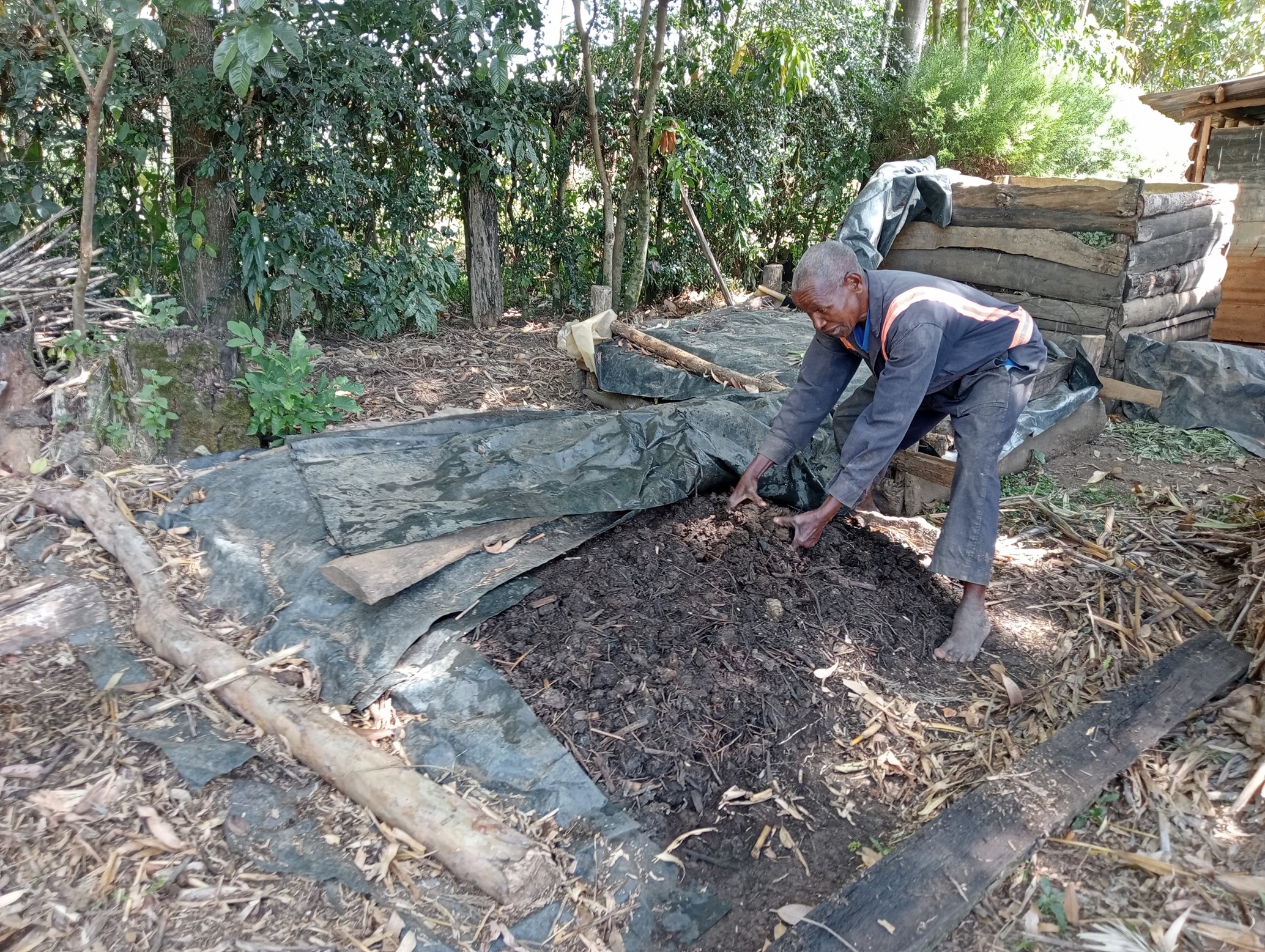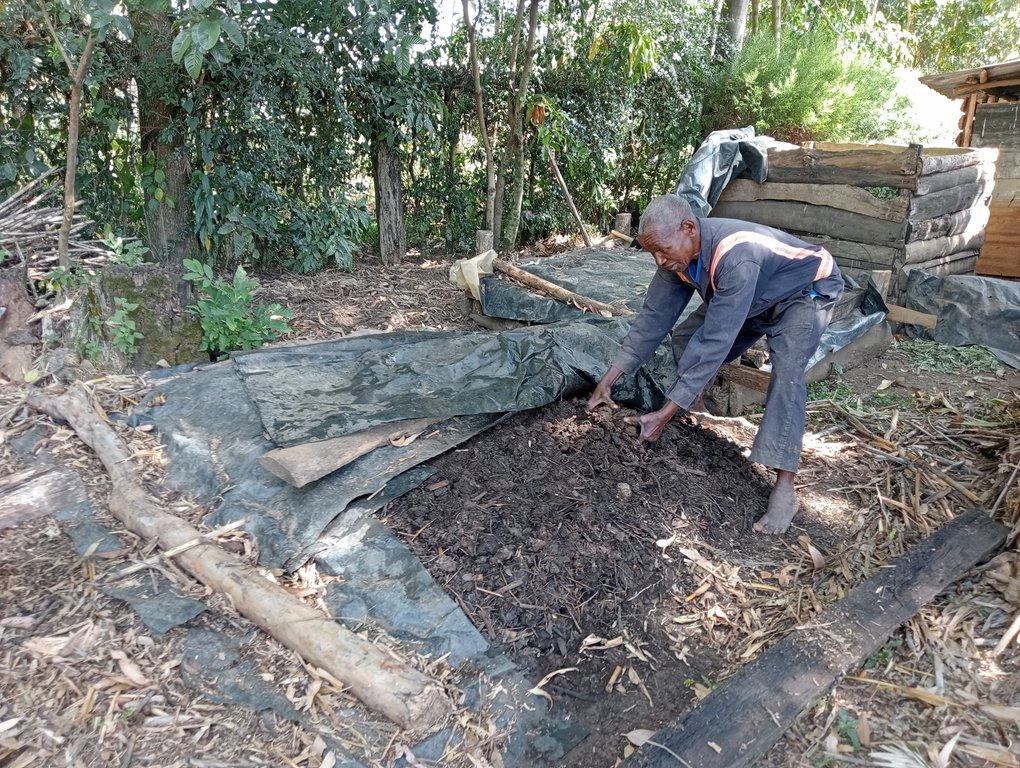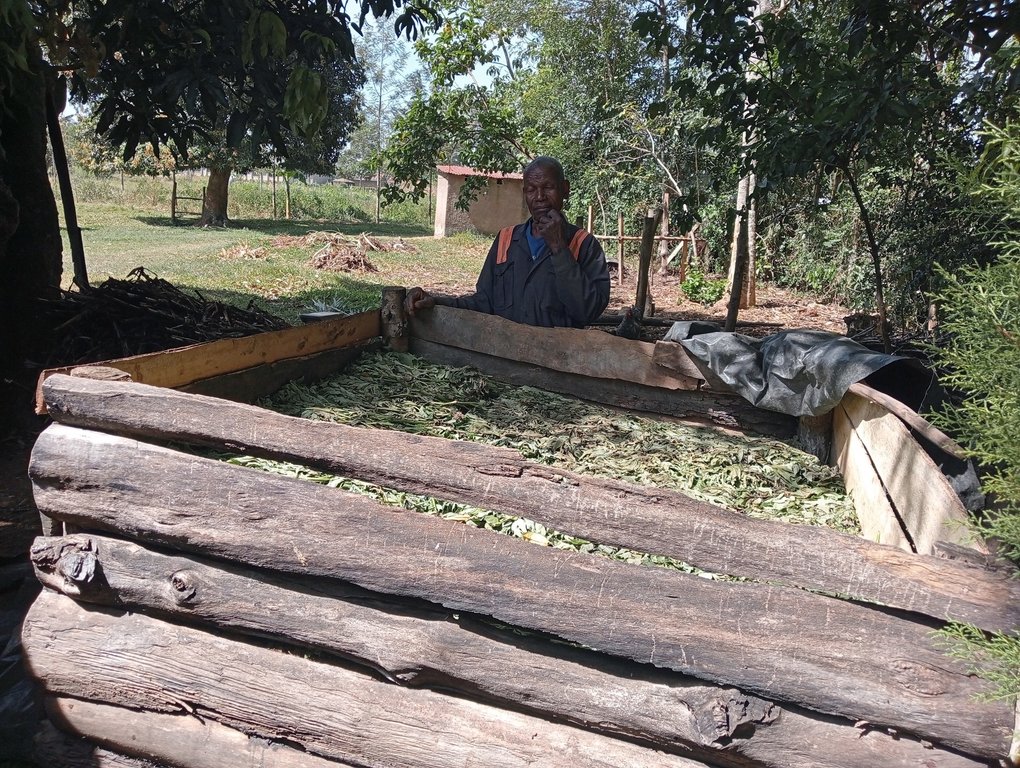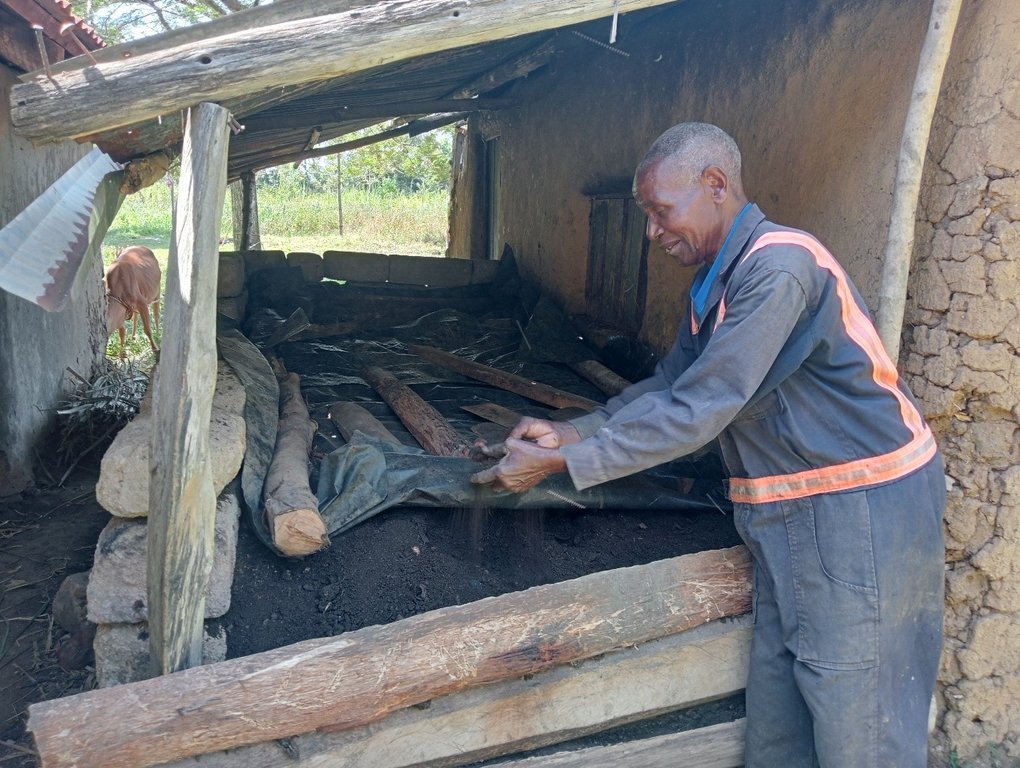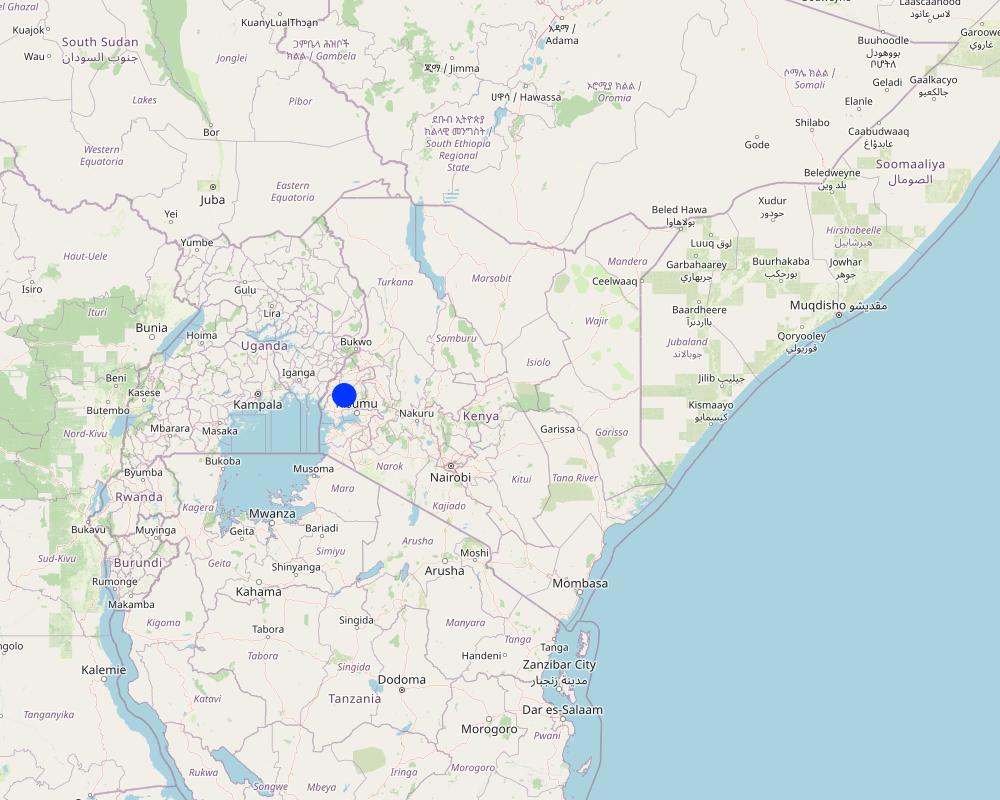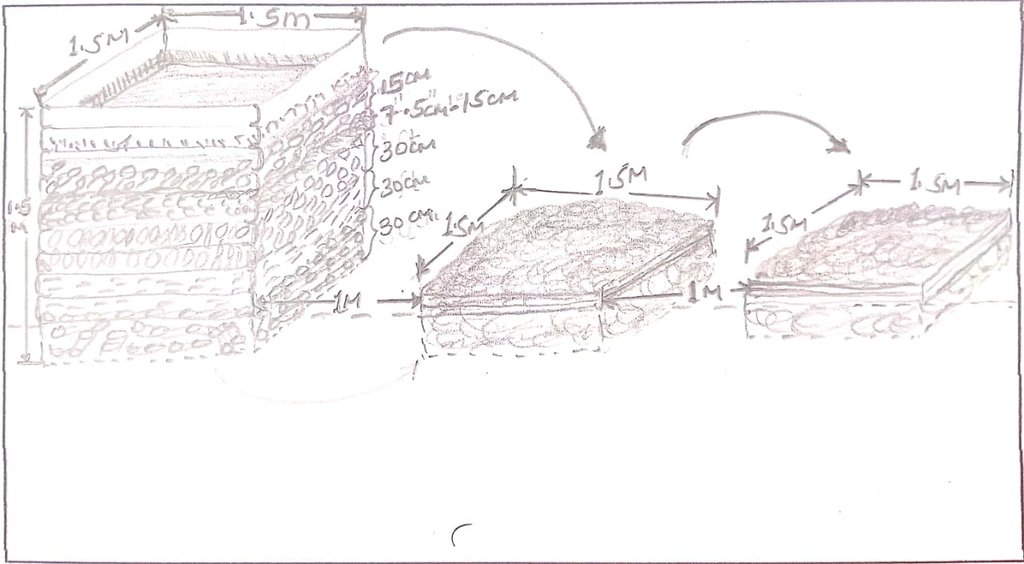Compost for organic waste management and improved crop yields [เคนยา]
- ผู้สร้างสรรค์:
- การอัพเดท:
- ผู้รวบรวม: William Akwanyi
- ผู้เรียบเรียง: George Onyango, Innocent Faith, Noel Templer, Tabitha Nekesa, Ahmadou Gaye, Siagbé Golli
- ผู้ตรวจสอบ: William Critchley, Rima Mekdaschi Studer, Sally Bunning
Mbolea bora (Kiswahili)
technologies_6648 - เคนยา
ดูส่วนย่อย
ขยายทั้งหมด ย่อทั้งหมด1. ข้อมูลทั่วไป
1.2 รายละเอียดที่ติดต่อได้ของผู้รวบรวมและองค์กรที่เกี่ยวข้องในการประเมินและการจัดเตรียมทำเอกสารของเทคโนโลยี
วิทยากรหลัก
ผู้ใช้ที่ดิน:
Anyanga Matthews George
Welthungerhilfe
เคนยา
ผู้เชี่ยวชาญ SLM:
ผู้เชี่ยวชาญ SLM:
ชื่อของโครงการซึ่งอำนวยความสะดวกในการทำเอกสารหรือการประเมินเทคโนโลยี (ถ้าเกี่ยวข้อง)
Soil protection and rehabilitation for food security (ProSo(i)l)ชื่อขององค์กรซึ่งอำนวยความสะดวกในการทำเอกสารหรือการประเมินเทคโนโลยี (ถ้าเกี่ยวข้อง)
Deutsche Gesellschaft für Internationale Zusammenarbeit (GIZ)ชื่อขององค์กรซึ่งอำนวยความสะดวกในการทำเอกสารหรือการประเมินเทคโนโลยี (ถ้าเกี่ยวข้อง)
CIAT International Center for Tropical Agriculture (CIAT International Center for Tropical Agriculture) - เคนยา1.3 เงื่อนไขการใช้ข้อมูลที่ได้บันทึกผ่านทาง WOCAT
ผู้รวบรวมและวิทยากรหลักยอมรับเงื่อนไขเกี่ยวกับการใช้ข้อมูลที่ถูกบันทึกผ่านทาง WOCAT:
ใช่
1.4 การเปิดเผยเรื่องความยั่งยืนของเทคโนโลยีที่ได้อธิบายไว้
เทคโนโลยีที่ได้อธิบายไว้นี้เป็นปัญหาของความเสื่อมโทรมโทรมของที่ดินหรือไม่ จึงไม่ได้รับการยอมรับว่าเป็นเทคโนโลยีเพื่อการจัดการที่ดินอย่างยั่งยืน:
ไม่ใช่
แสดงความคิดเห็น:
Farmers who have implemented the technology have recorded good harvests from their farms. The product of manure has improved their soils.
1.5 Reference to Questionnaire(s) on SLM Approaches (documented using WOCAT)
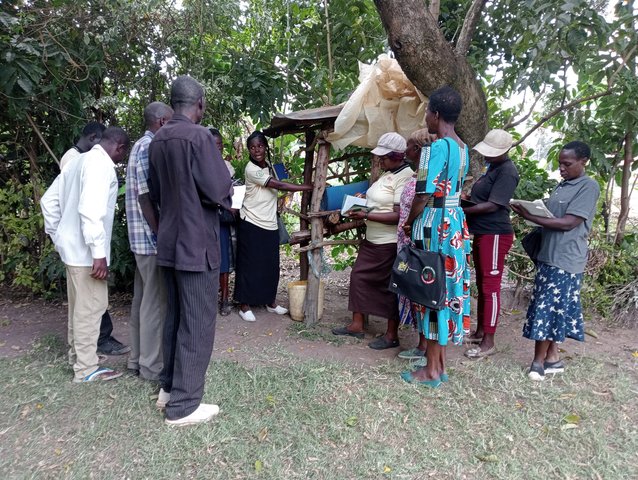
Community Resource Persons (CRP) in agricultural extension [เคนยา]
Community Resource Persons (CRP) form a farmer-to-farmer learning approach that bridges the gap in agricultural extension, increases farmers' access to agricultural information (SLM knowledge), and increases the adoption of SLM practices.
- ผู้รวบรวม: William Akwanyi
2. การอธิบายลักษณะของเทคโนโลยี SLM
2.1 การอธิบายแบบสั้น ๆ ของเทคโนโลยี
คำจำกัดความของเทคโนโลยี:
Composting with on-farm organic solid waste management improves the soil sustainably and raises crop yields.
2.2 การอธิบายแบบละเอียดของเทคโนโลยี
คำอธิบาย:
Composting is a natural process of converting organic materials such as plant leaves, and food remains into a nutrient-rich soil-enhancing amendment called compost (if mainly from vegetative matter) or manure (if mainly from animal dung). It involves breaking organic matter down into humus/ compost by aerobic microorganisms - with by-products of water, heat, ammonia (NH3), and carbon dioxide (CO2). Humus is a dark and crumbly natural form of fertilizer applied to the soil to improve crop production. Composting is cost-effective since it can be made from locally available materials such as leaves, plant residues, food remains, cow dung, poultry droppings, animal urine, soil, etc. Composting is thus an on-farm solid waste management measure. When made correctly it can improve carbon sequestration in the soil (compost is carbon-rich) and prevent methane emissions (a greenhouse gas) since methane-producing microbes become inactive in aerobic conditions (in the presence of oxygen).
There are many ways of preparing compost. This method involves three key stages; mixing brown organic materials, such as twigs, and green materials, such as fresh leaves that are nitrogen-rich and moist. In the first stage, brown and green materials are layered, beginning with a 30 cm layer of twigs at the bottom, followed by a 30 cm layer of dry matter, such as maize straw chopped to a maximum of 7.5 cm. This is followed by a 30 cm layer of dry grass and dry leaves covered by a 7.5 cm – 15 cm layer of fresh cow dung. The fresh cow dung is covered by a 15 cm layer of fresh tithonia (an exotic plant) that is completely covered by a layer of ash and sprayed uniformly using 10 litres of animal urine and finally completely covered by a layer of soil or manure. All the above inputs except urine are sprayed with 10 – 20 litres of water. The pile is then completely covered with a black polythene sheet to help absorb heat, prevent the entry of rainwater, and prevent volatilization of nitrogen, i.e., the conversion of ammonium into ammonia gas, and left to decompose for 21 to 30 days.
The second stage involves mixing and transferring all the material except the twigs, to another space. The heap is again completely covered with a black polythene sheet to help absorb heat, prevent rainwater entry, and prevent nitrogen volatilization. It is again left to decompose for another 21 to 30 days. The third stage, like the second stage, involves completely mixing and transferring all the material from the second stage to another space and completely covering the heap with a black polythene sheet to help absorb heat and prevent the entry of rainwater. The contents are allowed to decompose for another 21 to 30 days, after which they are ready-to-use compost. The compost is stored under shade and covered with a black polythene sheet again to prevent nitrogen volatilization.
One heap of compost (first stage: 1.5 m by 1.5 m by 1.5 m) produces about 5 tonnes of ready-to-use compost. Composting takes about 90 days; hence, provided that all inputs are available, a farmer can produce compost 4 times each year from the same heaping point, i.e., about 20 tonnes. Normally, a 0.4-hectare farm requires about 20 tonnes of this compost. However, the amount varies from farm to farm depending on the conditions of the soil and the crop(s) to be grown. It is important that soil testing is done to determine the conditions of the soil to ensure that the compost is being used in the most effective manner.
Compost is carried to the farm on wheelbarrows and in buckets and is applied at the farm during planting time where a handful of compost is applied in the planting hole and mixed with soil before planting. It is again applied around the base of the crop and completely covered with soil. Preparation of compost in conservation agriculture situations could pose the problem of competition for plant material since plant material is used in conservation agriculture to cover the soil. To manage this, a farmer implementing both composting and conservation agriculture may have to acquire plant material for composting from other sources such as purchasing stover from other farmer who are not implementing conservation agriculture. In addition, the farmer could also use hedge trimmings as plant material for composting, especially if the farmer has a live fence.
2.3 รูปภาพของเทคโนโลยี
คำอธิบายภาพ:
Composting is a multi-stage process. The inputs/ materials in each stage must be completely covered with a black polythene sheet to help absorb heat, prevent the entry of rainwater, and prevent volatilization of nitrogen. The materials are allowed to decompose for at least 21 days in each stage before they are completely mixed and transferred to the next.
2.5 ประเทศภูมิภาค หรือสถานที่ตั้งที่เทคโนโลยีได้นำไปใช้และได้รับการครอบคลุมโดยการประเมินนี้
ประเทศ:
เคนยา
ภูมิภาค/รัฐ/จังหวัด:
Kakamega County in western Kenya
ข้อมูลจำเพาะเพิ่มเติมของสถานที่ตั้ง :
Elang'ata Village, Bulanda Sub-location, Imanga Location, Marama Central Ward, Butere Sub-county
ระบุการกระจายตัวของเทคโนโลยี:
- ใช้ ณ จุดที่เฉพาะเจาะจงหรือเน้นไปยังบริเวณพื้นที่ขนาดเล็ก
Is/are the technology site(s) located in a permanently protected area?
ไม่ใช่
แสดงความคิดเห็น:
The farm where the technology is implemented is not in a protected area.
Map
×2.6 วันที่การดำเนินการ
ระบุปีที่ใช้:
2018
2.7 คำแนะนำของเทคโนโลยี
ให้ระบุว่าเทคโนโลยีถูกแนะนำเข้ามาอย่างไร:
- ด้วยการริเริ่มของผู้ใช้ที่ดินเอง
- เป็นส่วนหนึ่งของระบบแบบดั้งเดิมที่ทำก้นอยู่ (> 50 ปี)
- ทางโครงการหรือจากภายนอก
ความคิดเห็น (ประเภทของโครงการ เป็นต้น) :
For years, the farmer has been converting farm wastes into manure. However, the Soil Protection and Rehabilitation of Degraded Soil for Food Security (ProSoil) project came in and taught them an improved method of composting that takes a shorter time compared with the traditional method, and prevents loss of nutrients during composting.
3. การจัดประเภทของเทคโนโลยี SLM
3.1 วัตถุประสงค์หลักของเทคโนโลยี
- ปรับปรุงการผลิตให้ดีขึ้น
- ลด ป้องกัน ฟื้นฟู การเสื่อมโทรมของที่ดิน
- ปรับตัวเข้ากับการเปลี่ยนแปลงภูมิอากาศของโลก สภาพภูมิอากาศที่รุนแรงและผลกระทบ
- ชะลอการเปลี่ยนแปลงภูมิอากาศของโลกและผลกระทบ
- สร้างผลกระทบทางด้านเศรษฐกิจที่เป็นประโยชน์
3.2 ประเภทของการใช้ที่ดินในปัจจุบันที่ได้นำเทคโนโลยีไปใช้
Land use mixed within the same land unit:
ใช่
Specify mixed land use (crops/ grazing/ trees):
- การปลูกพืชร่วมกับปศุสัตว์และการทำป่าไม้ (Agro-silvopastoralism)

พื้นที่ปลูกพืช
- การปลูกพืชล้มลุกอายุปีเดียว
- การปลูกพืชยืนต้นที่ไม่มีเนื้อไม้
- การปลูกไม้ยืนต้น ไม้พุ่ม
Annual cropping - Specify crops:
- fodder crops - grasses
- cereals - maize
- vegetables - other
- legumes and pulses - beans
- root/tuber crops - cassava
Annual cropping system:
Maize/sorghum/millet intercropped with legume
Perennial (non-woody) cropping - Specify crops:
- banana/plantain/abaca
Tree and shrub cropping - Specify crops:
- avocado
- fruits, other
- mango, mangosteen, guava
- papaya
จำนวนของฤดูเพาะปลูกต่อปี:
- 2
ระบุ:
Long and short rain seasons
Is intercropping practiced?
ใช่
If yes, specify which crops are intercropped:
Maize and beans
Is crop rotation practiced?
ใช่
ถ้าใช่ ระบุ:
Some sections of the farm are left fallow during the short rains to allow for soil regeneration.

ทุ่งหญ้าเลี้ยงสัตว์
ทุ่งหญ้าเลี้ยงสัตว์ที่มีการจัดการแบบเข้มข้นหรือการผลิตอาหารสัตว์:
- ตัดแล้วขนไป / ไม่มีการปล่อยแทะเล็มเอง (Cut-and-carry / zero grazing)
- ทุ่งหญ้าเลี้ยงสัตว์ที่ได้มีการปรับปรุง (Improved pastures)
Animal type:
- cattle - dairy
- cattle - dairy and beef (e.g. zebu)
- poultry
Is integrated crop-livestock management practiced?
ใช่
ถ้าใช่ ระบุ:
Cattle dung and poultry droppings are used as inputs in composting. Compost is applied on soil where livestock fodder is planted.
ผลิตภัณฑ์และบริการ:
- economic security, investment prestige
- milk
- manure as fertilizer/ energy production
- eggs
- meat
Species:
cattle - dairy
Count:
2
Species:
cattle - dairy and beef (e.g. zebu)
Count:
3
Species:
poultry
Count:
10
แสดงความคิดเห็น:
There are assorted trees on the farm, and these provide litter which is an input in composting.
3.3 Has land use changed due to the implementation of the Technology?
Has land use changed due to the implementation of the Technology?
- No (Continue with question 3.4)
3.4 การใช้น้ำ
การใช้น้ำของที่ดินที่มีการใช้เทคโนโลยีอยู่:
- จากน้ำฝน
แสดงความคิดเห็น:
Crops are planted only during the rainy seasons since there is no irrigation.
3.5 กลุ่ม SLM ที่ตรงกับเทคโนโลยีนี้
- การจัดการปลูกพืชร่วมกับปศุสัตว์
- การจัดการความอุดมสมบรูณ์ของดินแบบผสมผสาน
- การจัดการของเสีย / การจัดการน้ำเสีย
3.6 มาตรการ SLM ที่ประกอบกันเป็นเทคโนโลยี

มาตรการจัดการพืช
- A2: อินทรียวัตถุในดิน/ความอุดมสมบูรณ์ในดิน
- A6: Residue management
A6: Specify residue management:
A 6.3: collected
แสดงความคิดเห็น:
Plant residues, especially leaves and soft branches are collected and used as input in composting. However, some plant matter is retained in the farm to naturally decompose and turn into manure at the farm. The farmer does not collect plant residues from protected areas. He has planted tithonia at some sections of the hedges at his farm; this provides the main source of tithonia. However, he sometimes harvests tithonia from his neighbours' hedges upon request.
3.7 รูปแบบหลักของการเสื่อมโทรมของที่ดินที่ได้รับการแก้ไขโดยเทคโนโลยี

การเสื่อมโทรมของดินทางด้านเคมี
- Cn (Fertility decline): ความอุดมสมบูรณ์และปริมาณอินทรียวัตถุในดินถูกทำให้ลดลงไป (ไม่ได้เกิดจากสาเหตุการกัดกร่อน)
- Ca (Acidification): การเกิดกรด
- Cp (Soil pollution): มลพิษในดิน
แสดงความคิดเห็น:
Covering of compost-making materials and the final compost reduces loss of nitrogen through volatilization of ammonium into ammonia gas. Compost raises the pH of soils when applied at the farm. Compost contains living organisms (bacteria and fungi) that degrade soil pollutants into non-toxic substances.
3.8 การป้องกัน การลดลง หรือการฟื้นฟูความเสื่อมโทรมของที่ดิน
ระบุเป้าหมายของเทคโนโลยีกับความเสื่อมโทรมของที่ดิน:
- ป้องกันความเสื่อมโทรมของที่ดิน
- ฟื้นฟูบำบัดที่ดินที่เสื่อมโทรมลงอย่างมาก
แสดงความคิดเห็น:
Compost improves soil structure and porosity. Compost balances soil pH.
4. ข้อมูลจำเพาะด้านเทคนิค กิจกรรมการนำไปปฏิบัติใช้ ปัจจัยนำเข้า และค่าใช้จ่าย
4.1 แบบแปลนทางเทคนิคของเทคโนโลยี
ข้อมูลจำเพาะด้านเทคนิค (แบบแปลนทางเทคนิคของเทคโนโลยี):
Stage 1: about 30 cm deep under the ground, 1.5 m long by 1.5 m wide by 1.5 m high, including the 30 cm below the ground. Constructed using timber off-cuts (locally known as magogo) supported on posts at corners using nails. From bottom: 30 cm of twigs to extend some few inches above the ground to allow air circulation, 30 cm of dry matter e.g., maize straw chopped to 7.5 cm maximum, 30 cm dry grass and leaves, 7.5 cm - 15 cm layer of fresh cow dung, 15 cm layer of fresh tithonia, layer of ash, layer of soil or manure, black polythene sheet cover.
Stages 2 and 3: about 1-ft deep under the ground, 1.5 m long by 1.5 m wide, height depends on the volume of the material.
Allow space of no more than 1 m from one stage to the other for easy of mixing and transfer of materials from one stage to the next.
ผู้เขียน:
William Onura
วันที่:
26/01/2023
4.2 ข้อมูลทั่วไปเกี่ยวกับการคำนวณปัจจัยนำเข้าและค่าใช้จ่าย
ให้ระบุว่าค่าใช้จ่ายและปัจจัยนำเข้าได้รับการคำนวณอย่างไร:
- ต่อหน่วยเทคโนโลยี
โปรดระบุหน่วย:
Heap of compost
Specify dimensions of unit (if relevant):
1.5 m by 1.5 m by 1.5 m
อื่นๆ หรือสกุลเงินประจำชาติ (ระบุ):
KES
If relevant, indicate exchange rate from USD to local currency (e.g. 1 USD = 79.9 Brazilian Real): 1 USD =:
122.95
ระบุค่าเฉลี่ยของค่าจ้างในการจ้างแรงงานต่อวัน:
200
4.3 กิจกรรมเพื่อการจัดตั้ง
| กิจกรรม | Timing (season) | |
|---|---|---|
| 1. | Digging of pits | At least 3 months before planting time |
| 2. | Framework construction with off cuts | At least 3 months before planting time |
| 3. | Filling stage one with inputs | At least 3 months before planting time |
แสดงความคิดเห็น:
Composting takes about 3 months; hence, the farmer should have the structures for composting at least 3 months before the planting time. A farmer can produce 20 tonnes of compost from 1 heap (1.5 m by 1.5 m by 1.5 m).
4.4 ค่าใช้จ่ายของปัจจัยนำเข้าที่จำเป็นสำหรับการจัดตั้ง
| ปัจจัยนำเข้า | หน่วย | ปริมาณ | ค่าใช้จ่ายต่อหน่วย | ค่าใช้จ่ายทั้งหมดต่อปัจจัยนำเข้า | %ของค่าใช้จ่ายที่ก่อให้เกิดขึ้นโดยผู้ใช้ที่ดิน | |
|---|---|---|---|---|---|---|
| แรงงาน | Framework construction | Man-days | 2.0 | 200.0 | 400.0 | 100.0 |
| แรงงาน | Filling inputs | Man-days | 1.0 | 200.0 | 200.0 | 100.0 |
| อุปกรณ์ | Jembe (hoe) | No. | 1.0 | 80.0 | 80.0 | |
| อุปกรณ์ | Spade | No. | 1.0 | 90.0 | 90.0 | |
| อุปกรณ์ | Fork hoe | No. | 1.0 | 70.0 | 70.0 | |
| อุปกรณ์ | Wheelbarrow | No. | 1.0 | 800.0 | 800.0 | |
| อุปกรณ์ | Hummer | No. | 1.0 | 100.0 | 100.0 | 100.0 |
| อุปกรณ์ | Handsaw | No. | 1.0 | 200.0 | 200.0 | 100.0 |
| วัสดุด้านพืช | Twigs | Wheelbarrow | 2.0 | 100.0 | 200.0 | 100.0 |
| วัสดุด้านพืช | Dry matter | Wheelbarrow | 6.0 | 50.0 | 300.0 | 100.0 |
| วัสดุด้านพืช | Dry grass and leaves | 90 Kg sack | 3.0 | 50.0 | 150.0 | 100.0 |
| วัสดุด้านพืช | Fresh tithonia | 90 Kg sack | 3.0 | 50.0 | 150.0 | 100.0 |
| ปุ๋ยและสารฆ่า/ยับยั้งการเจริญเติบโตของสิ่งมีชีวิต (ไบโอไซด์) | Ash | 90 Kg sack | 0.4 | 200.0 | 80.0 | 100.0 |
| ปุ๋ยและสารฆ่า/ยับยั้งการเจริญเติบโตของสิ่งมีชีวิต (ไบโอไซด์) | Animal urine | 10 litre container | 1.0 | 125.0 | 125.0 | 100.0 |
| ปุ๋ยและสารฆ่า/ยับยั้งการเจริญเติบโตของสิ่งมีชีวิต (ไบโอไซด์) | Soil or manure | Wheelbarrow | 1.0 | 300.0 | 300.0 | 100.0 |
| ปุ๋ยและสารฆ่า/ยับยั้งการเจริญเติบโตของสิ่งมีชีวิต (ไบโอไซด์) | Fresh cow dung | Wheelbarrow | 3.0 | 200.0 | 600.0 | 100.0 |
| วัสดุสำหรับก่อสร้าง | Timber off-cuts | Pieces | 16.0 | 100.0 | 1600.0 | 100.0 |
| วัสดุสำหรับก่อสร้าง | Wooden posts | Pieces | 4.0 | 50.0 | 200.0 | 100.0 |
| วัสดุสำหรับก่อสร้าง | Nails (assorted sizes) | Kgs | 3.0 | 200.0 | 600.0 | 100.0 |
| อื่น ๆ | Water | 20 litres container | 4.0 | 5.0 | 20.0 | 100.0 |
| ค่าใช้จ่ายทั้งหมดของการจัดตั้งเทคโนโลยี | 6265.0 | |||||
| Total costs for establishment of the Technology in USD | 50.96 | |||||
ถ้าผู้ใช้ที่ดินรับภาระน้อยกว่า 100% ของค่าใช้จ่าย ให้ระบุว่าใครเป็นผู้รับผิดชอบส่วนที่เหลือ:
ProSoil project
แสดงความคิดเห็น:
The ProSoil project through Welthungerhilfe provided hoes, fork hoes, wheelbarrows, and spades to the farmers. The costs of these implements are KES 400/- for a hoe, KES 350/- for a fork hoe, KES 4,000/- for a wheelbarrow, KES 450/- for a spade, KES 500/- for a hummer, and KES 1,000/- for a handsaw. It is assumed that the farmer will be able to use the hoe, fork hoe, spade, hummer, and handsaw over a period of 5 years, and a wheelbarrow over a period of 10 years before these implements will have depreciated to a point where they will not be useable. The cost is thus spread over the years when the farmer will be able to use the implement.
4.5 การบำรุงรักษาสภาพหรือกิจกรรมที่เกิดขึ้นเป็นประจำ
| กิจกรรม | ช่วงระยะเวลา/ความถี่ | |
|---|---|---|
| 1. | Turning at each stage | 21 - 30 days after start of each stage |
| 2. | Refilling at the first stage | At turning from the first stage |
| 3. | Distribution to the farm | When planting and at first weeding (i.e., 3rd week after planting) |
แสดงความคิดเห็น:
Turning involves complete mixing and transfer of the inputs from one stage to the next. Compost is applied at the farm during planting time where a handful of compost is applied in the planting hole and mixed with soil before planting. It is again applied around the base of the crop and completely covered with soil.
4.6 ค่าใช้จ่ายของปัจจัยนำเข้าและกิจกรรมที่เกิดขึ้นเป็นประจำที่ต้องการการบำรุงรักษา (ต่อปี)
| ปัจจัยนำเข้า | หน่วย | ปริมาณ | ค่าใช้จ่ายต่อหน่วย | ค่าใช้จ่ายทั้งหมดต่อปัจจัยนำเข้า | %ของค่าใช้จ่ายที่ก่อให้เกิดขึ้นโดยผู้ใช้ที่ดิน | |
|---|---|---|---|---|---|---|
| แรงงาน | Complete mixing and turning from stage one to stage two and from stage two to stage three | Man-days | 4.0 | 200.0 | 800.0 | 100.0 |
| แรงงาน | Refilling with new materials at the first stage | Man-days | 1.0 | 200.0 | 200.0 | 100.0 |
| แรงงาน | Transfer to storage | Man-days | 2.0 | 200.0 | 400.0 | 100.0 |
| แรงงาน | Distribution to the farm | Man-days | 2.0 | 200.0 | 400.0 | 100.0 |
| อุปกรณ์ | Hoe | No. | 1.0 | 80.0 | 80.0 | |
| อุปกรณ์ | Fork hoe | No. | 1.0 | 90.0 | 90.0 | |
| อุปกรณ์ | Spade | No. | 1.0 | 70.0 | 70.0 | |
| อุปกรณ์ | Wheelbarrow | No. | 1.0 | 400.0 | 400.0 | |
| วัสดุด้านพืช | Dry matter | Wheelbarrow | 6.0 | 50.0 | 300.0 | 100.0 |
| วัสดุด้านพืช | Dry grass and leaves | 90Kg sack | 3.0 | 50.0 | 150.0 | 100.0 |
| วัสดุด้านพืช | Fresh tithonia | 90Kg sack | 3.0 | 50.0 | 150.0 | 100.0 |
| ปุ๋ยและสารฆ่า/ยับยั้งการเจริญเติบโตของสิ่งมีชีวิต (ไบโอไซด์) | Ash | 90 Kg sack | 0.4 | 200.0 | 80.0 | 100.0 |
| ปุ๋ยและสารฆ่า/ยับยั้งการเจริญเติบโตของสิ่งมีชีวิต (ไบโอไซด์) | Animal urine | 10 litre container | 1.0 | 125.0 | 125.0 | 100.0 |
| ปุ๋ยและสารฆ่า/ยับยั้งการเจริญเติบโตของสิ่งมีชีวิต (ไบโอไซด์) | Soil or manure | Wheelbarrow | 1.0 | 300.0 | 300.0 | 100.0 |
| ปุ๋ยและสารฆ่า/ยับยั้งการเจริญเติบโตของสิ่งมีชีวิต (ไบโอไซด์) | Fresh cowdung | Wheelbarrow | 3.0 | 200.0 | 600.0 | 100.0 |
| อื่น ๆ | Water | 20 litres container | 4.0 | 5.0 | 20.0 | 100.0 |
| ค่าใช้จ่ายทั้งหมดของการบำรุงรักษาสภาพเทคโนโลยี | 4165.0 | |||||
| Total costs for maintenance of the Technology in USD | 33.88 | |||||
ถ้าผู้ใช้ที่ดินรับภาระน้อยกว่า 100% ของค่าใช้จ่าย ให้ระบุว่าใครเป็นผู้รับผิดชอบส่วนที่เหลือ:
ProSoil project
แสดงความคิดเห็น:
The hoes, fork hoes, wheelbarrows, and spades provided by the ProSoil project through Welthungerhilfe are fixed assets and are used for years by the farmer before they can wear out. The farmer can use these implements for other work at the farm. The costs of these implements are KES 400/- for a hoe, KES 350/- for a fork hoe, KES 4,000/- for a wheelbarrow, and KES 450/- for a spade. It is assumed that the farmer will be able to use the hoe, fork hoe, and spade over a period of 5 years, and a wheelbarrow over a period of 10 years before these implements will have depreciated to a point where they will not be useable. The cost is thus spread over the years when the farmer will be able to use the implement. The twigs are reused during the refilling process since they take long to decompose.
4.7 ปัจจัยสำคัญที่สุดที่มีผลกระทบต่อค่าใช้จ่าย
ปัจจัยสำคัญที่สุดที่มีผลกระทบต่อค่าใช้จ่ายต่างๆ:
Rate of man-days vary from one place to another. It is not easy to attach monetary value to some of the input e.g., animal urine, cow dung, and water.
Exchange rate for January 2023, source: European Commission/ InfoEuro online at https://commission.europa.eu/funding-tenders/procedures-guidelines-tenders/information-contractors-and-beneficiaries/exchange-rate-inforeuro_en
5. สิ่งแวดล้อมทางธรรมชาติและของมนุษย์
5.1 ภูมิอากาศ
ฝนประจำปี
- < 250 ม.ม.
- 251-500 ม.ม.
- 501-750 ม.ม.
- 751-1,000 ม.ม.
- 1,001-1,500 ม.ม.
- 1,501-2,000 ม.ม.
- 2,001-3,000 ม.ม.
- 3,001-4,000 ม.ม.
- > 4,000 ม.ม.
ข้อมูลจำเพาะ/ความคิดเห็นเรื่องปริมาณน้ำฝน:
Monthly rainfall variability is high with some months such as January recording less than 5 mm of total rainfall.
ระบุชื่อของสถานีตรวดวัดอากาศที่ใช้อ้างอิงคือ:
Kakamega Meteorological Station
เขตภูมิอากาศเกษตร
- ชื้น
The climate in the area favours most agricultural activities.
5.2 สภาพภูมิประเทศ
ค่าเฉลี่ยความลาดชัน:
- ราบเรียบ (0-2%)
- ลาดที่ไม่ชัน (3-5%)
- ปานกลาง (6-10%)
- เป็นลูกคลื่น (11-15%)
- เป็นเนิน (16-30%)
- ชัน (31-60%)
- ชันมาก (>60%)
ธรณีสัณฐาน:
- ที่ราบสูง/ที่ราบ
- สันเขา
- ไหล่เขา
- ไหล่เนินเขา
- ตีนเนิน
- หุบเขา
ระดับความสูง:
- 0-100 เมตร
- 101-500 เมตร
- 501-1,000 เมตร
- 1,001-1,500 เมตร
- 1,501-2,000 เมตร
- 2,001-2,500 เมตร
- 2,501-3,000 เมตร
- 3,001-4,000 เมตร
- > 4,000 เมตร
ให้ระบุถ้าเทคโนโลยีได้ถูกนำไปใช้:
- ไม่เกี่ยวข้อง
ความคิดเห็นและข้อมูลจำเพาะเพิ่มเติมเรื่องสภาพภูมิประเทศ:
The farm is located at an area that is higher in altitude compared to other areas in the larger area. The average altitude for the area is 1,350m above sea level but the farm is at 1,401m above sea level.
5.3 ดิน
ค่าเฉลี่ยความลึกของดิน:
- ตื้นมาก (0-20 ซ.ม.)
- ตื้น (21-50 ซ.ม.)
- ลึกปานกลาง (51-80 ซ.ม.)
- ลึก (81-120 ซ.ม.)
- ลึกมาก (>120 ซ.ม.)
เนื้อดิน (ดินชั้นบน):
- ปานกลาง (ดินร่วน ทรายแป้ง)
เนื้อดินล่าง (> 20 ซ.ม.ต่ำจากผิวดิน):
- หยาบ/เบา (ดินทราย)
อินทรียวัตถุในดิน:
- ปานกลาง (1-3%)
(ถ้ามี) ให้แนบคำอธิบายเรื่องดินแบบเต็มหรือระบุข้อมูลที่มีอยู่ เช่น ชนิดของดิน ค่า pH ของดินหรือความเป็นกรดของดิน ความสามารถในการแลกเปลี่ยนประจุบวก ไนโตรเจน ความเค็ม เป็นต้น:
Soil pH of most farms in the area ranges from moderately acid (5.50) to moderately alkaline (7.80).
5.4 ความเป็นประโยชน์และคุณภาพของน้ำ
ระดับน้ำใต้ดิน:
5-50 เมตร
น้ำไหลบ่าที่ผิวดิน:
ดี
คุณภาพน้ำ (ที่ยังไม่ได้บำบัด):
เป็นน้ำเพื่อการดื่มที่ไม่ดี (จำเป็นต้องได้รับการบำบัด)
Water quality refers to:
both ground and surface water
ความเค็มของน้ำเป็นปัญหาหรือไม่:
ไม่ใช่
กำลังเกิดน้ำท่วมในพื้นที่หรือไม่:
ไม่ใช่
ความคิดเห็นและข้อมูลจำเพาะเพิ่มเติมเรื่องคุณภาพและปริมาณน้ำ:
There are several boreholes in the area and according to interviews with some borehole owners, the depts are not more than 50 metres.
5.5 ความหลากหลายทางชีวภาพ
ความหลากหลายทางชนิดพันธุ์:
- ปานกลาง
ความหลากหลายของแหล่งที่อยู่:
- ปานกลาง
ความคิดเห็นและข้อมูลจำเพาะเพิ่มเติมของความหลากหลายทางชีวภาพ:
The area has high agrobiodiversity since most farms are under crops and trees.
5.6 ลักษณะของผู้ใช้ที่ดินที่นำเทคโนโลยีไปปฏิบัติใช้
อยู่กับที่หรือเร่ร่อน:
- กึ่งเร่ร่อน
แนวทางการตลาดของระบบการผลิต:
- mixed (subsistence/ commercial)
รายได้ที่มาจากนอกฟาร์ม:
- > 50% ของรายได้ทั้งหมด
ระดับของความมั่งคั่งโดยเปรียบเทียบ:
- พอมีพอกิน
เป็นรายบุคคล/ครัวเรือน:
- เป็นรายบุคคล/ครัวเรือน
ระดับของการใช้เครื่องจักรกล:
- งานที่ใช้แรงกาย
- การใช้กำลังจากสัตว์
เพศ:
- หญิง
- ชาย
อายุของผู้ใช้ที่ดิน:
- ผู้เยาว์
- วัยกลางคน
- ผู้สูงอายุ
ระบุลักษณะอื่นๆที่เกี่ยวข้องของผู้ใช้ที่ดิน:
The farmer uses the land together with his other family members.
5.7 Average area of land used by land users applying the Technology
- < 0.5 เฮกตาร์
- 0.5-1 เฮกตาร์
- 1-2 เฮกตาร์
- 2-5 เฮกตาร์
- 5-15 เฮกตาร์
- 15-50 เฮกตาร์
- 50-100 เฮกตาร์
- 100-500 เฮกตาร์
- 500-1,000 เฮกตาร์
- 1,000-10,000 เฮกตาร์
- >10,000 เฮกตาร์
พิจารณาว่าเป็นขนาดเล็ก กลาง หรือขนาดใหญ่ (ซึ่งอ้างอิงถึงบริบทระดับท้องถิ่น):
- ขนาดกลาง
แสดงความคิดเห็น:
Farmers with more than 2 ha in the area are considered to have large pieces of land since there is high level of land fragmentation in the area.
5.8 กรรมสิทธิ์ในที่ดิน สิทธิในการใช้ที่ดินและสิทธิในการใช้น้ำ
กรรมสิทธิ์ในที่ดิน:
- รายบุคคล ไม่ได้รับสิทธิครอบครอง
- รายบุคคล ได้รับสิทธิครอบครอง
สิทธิในการใช้ที่ดิน:
- เช่า
- รายบุคคล
สิทธิในการใช้น้ำ:
- เข้าถึงได้แบบเปิด (ไม่ได้จัดระเบียบ)
- รายบุคคล
Are land use rights based on a traditional legal system?
ไม่ใช่
ระบุ:
Each landowner has full control of the way he/ she wants to use his/ her land.
แสดงความคิดเห็น:
The farmer has an official ownership title for his piece of land. He also leases other people's pieces of land for farming. Water in the streams and springs is freely accessed without restrictions. There is a borehole in the neighbourhood, and the managers of this borehole have set rules for accessing the water thereat.
5.9 การเข้าถึงบริการและโครงสร้างพื้นฐาน
สุขภาพ:
- จน
- ปานกลาง
- ดี
การศึกษา:
- จน
- ปานกลาง
- ดี
ความช่วยเหลือทางด้านเทคนิค:
- จน
- ปานกลาง
- ดี
การจ้างงาน (เช่น ภายนอกฟาร์ม):
- จน
- ปานกลาง
- ดี
ตลาด:
- จน
- ปานกลาง
- ดี
พลังงาน:
- จน
- ปานกลาง
- ดี
ถนนและการขนส่ง:
- จน
- ปานกลาง
- ดี
น้ำดื่มและการสุขาภิบาล:
- จน
- ปานกลาง
- ดี
บริการด้านการเงิน:
- จน
- ปานกลาง
- ดี
แสดงความคิดเห็น:
The above rating varies from one village to the other.
6. ผลกระทบและสรุปคำบอกกล่าว
6.1 ผลกระทบในพื้นที่ดำเนินการ (On-site) จากการใช้เทคโนโลยี
ผลกระทบทางด้านเศรษฐกิจและสังคม
การผลิต
การผลิตพืชผล
จำนวนก่อน SLM:
Less than 4
หลังจาก SLM:
More than 8
แสดงความคิดเห็น/ระบุ:
Quantity refers to the number of 90 Kg bags of maize produced per acre. Based on measurement by the farmer.
คุณภาพพืชผล
แสดงความคิดเห็น/ระบุ:
Not easy to quantify. The crops do better compared to how they could do in the past, yet he does not use inorganic fertilizers. Based on estimation by the farmer.
การผลิตพืชที่ใช้เลี้ยงปศุสัตว์
จำนวนก่อน SLM:
2
หลังจาก SLM:
3 - 4
แสดงความคิดเห็น/ระบุ:
Quantity refers to harvesting cycles for nappier grass from the same farm. He applies compost on the pieces of land where he has grown fodder. The fodder does better than how it used to do before when he was not applying compost.
คุณภาพพืชที่ใช้เลี้ยงปศุสัตว์
แสดงความคิดเห็น/ระบุ:
He applies compost on the pieces of land where he has grown fodder.
การผลิตสัตว์
จำนวนก่อน SLM:
1 - 3
หลังจาก SLM:
3 - 10
แสดงความคิดเห็น/ระบุ:
Quantity refers to the amount of milk in litres from one cow. He gets more milk from his cows as compared to what he used to get before the SLM since applying compost on the pieces of land where he has grown fodder makes the fodder to grow faster. Milk production is often at the peak during early lactation months.
การเสี่ยงต่อความล้มเหลวในการผลิต
จำนวนก่อน SLM:
Over 50
หลังจาก SLM:
Less than 10
แสดงความคิดเห็น/ระบุ:
Quantity refers to the percentage probability of the crop failing to do well. Quote from the farmer, '... it was 50 50 getting any produce before I started using compost ...' meaning that there was high chance that the crop could fail due to poor soils. Compost is a rich source of organic matter; hence, ensure sustainable agricultural production.
รายได้และค่าใช้จ่าย
ค่าใช่จ่ายของปัจจัยการผลิตทางการเกษตร
จำนวนก่อน SLM:
Over 5,000
หลังจาก SLM:
0
แสดงความคิดเห็น/ระบุ:
Quantity refers to the amount of money in Kenya shillings spend on inorganic fertilizers in a season. The farmers no longer spend money inorganic fertilizers.
รายได้จากฟาร์ม
จำนวนก่อน SLM:
Less than 2,000
หลังจาก SLM:
20,000
แสดงความคิดเห็น/ระบุ:
Quantity refers to the amount of money in Kenya shillings received from the sale of farm produce, including compost in a year. The farmer is able to sell surplus crop and animal products as a result of bumper harvest due to the use of compost on his farm.
ความหลากหลายของแหล่งผลิตรายได้
จำนวนก่อน SLM:
1 - 3
หลังจาก SLM:
More than 3
แสดงความคิดเห็น/ระบุ:
Quantity refers to household income sources, including sale of surplus farm produce and compost. The farmer is able to sell surplus crop and animal products, and other on-farm products such and compost.
ภาระงาน
จำนวนก่อน SLM:
Over 5
หลังจาก SLM:
Less than 1
แสดงความคิดเห็น/ระบุ:
Quantity refers to the number of hours that the farmer can be free in any working day. A lot of work is involved in the preparation and maintenance of compost in order to achieve the desired results.
ผลกระทบด้านสังคมวัฒนธรรมอื่น ๆ
ความมั่นคงด้านอาหาร / พึ่งตนเองได้
จำนวนก่อน SLM:
About 3 months of purchasing maize
หลังจาก SLM:
No months when there is total lack of food in the house
แสดงความคิดเห็น/ระบุ:
Quantity refers to the number of months in a year when there is total lack of food in the house, and the farmer has to buy all the food required in the house. The soils at the farm have been enhanced; hence, the farmer grows a variety of crops. Food is available in the household to sustain the family from one harvest to the next.
SLM หรือความรู้เรื่องความเสื่อมโทรมของที่ดิน
จำนวนก่อน SLM:
10%
หลังจาก SLM:
Over 90%
แสดงความคิดเห็น/ระบุ:
Quantity refers to the estimated percentage of knowledge in SLM/ land management. Not only is the farmer equipped with skills on how to make compost but also with skills in other SLM technologies such as vermicomposting.
ผลกระทบด้านนิเวศวิทยา
ดิน
ความชื้นในดิน
จำนวนก่อน SLM:
Less than 10
หลังจาก SLM:
20 or more
แสดงความคิดเห็น/ระบุ:
Quantity refers to the farmer's estimated soil moisture content during the dry season when soil moisture challenges are expected to be high.
สิ่งปกคลุมดิน
จำนวนก่อน SLM:
30 - 50
หลังจาก SLM:
60 - 80
แสดงความคิดเห็น/ระบุ:
Quantity refers to the farmer's estimated percentage soil cover at the farm.
อินทรียวัตถุในดิน/ต่ำกว่าดินชั้น C
แสดงความคิดเห็น/ระบุ:
Quantity refers to the farmer's estimated percentage of organic matter at the farm. Based on estimation by the farmer.
ความหลากหลายทางชีวภาพของพืชและสัตว์
การปกคลุมด้วยพืช
จำนวนก่อน SLM:
30 - 50
หลังจาก SLM:
60 - 80
แสดงความคิดเห็น/ระบุ:
Quantity refers to the farmer's estimated percentage vegetation cover at the farm.
ความหลากหลายทางชีวภาพของพืช
จำนวนก่อน SLM:
About 3
หลังจาก SLM:
More than 5
แสดงความคิดเห็น/ระบุ:
Quantity refers to the number of plants (crops) that the farmer establishes at the farm.
ชนิดพันธุ์ที่ให้ประโยชน์
แสดงความคิดเห็น/ระบุ:
Not easy to quantify but the number of earthworms in the farm and bees visiting the farm to look for nectar has increased.
ความหลากหลายของสัตว์
แสดงความคิดเห็น/ระบุ:
Not easy to quantify but the number of earthworms in the farm has increased which is an indication of increased habitats for different animals at the farm.
Specify assessment of on-site impacts (measurements):
No recorded data is available for reference. All are estimates based on the farmer's explanation or as given by him.
6.2 ผลกระทบนอกพื้นที่ดำเนินการ (Off-site) จากการใช้เทคโนโลยี
ความเสียหายต่อพื้นที่เพาะปลูกของเพื่อนบ้าน
จำนวนก่อน SLM:
80
หลังจาก SLM:
10
แสดงความคิดเห็น/ระบุ:
Quantity refers to the probability of the neighbours' farms being burned because of available plant residues. The farmer collects residues from his neighbours' farms for use in composting. The neighbours could have burned the residues leading to death of useful microorganisms (bacteria and fungi).
ผลกระทบของก๊าซเรือนกระจก
แสดงความคิดเห็น/ระบุ:
Not easy to quantify. Composting improves carbon sequestration in the soil and by preventing methane emissions through aerobic decomposition, as methane-producing microbes are not active in aerobic conditions.
Specify assessment of off-site impacts (measurements):
No recorded data is available for reference. All are estimates based on the farmer's explanation or as given by him.
6.3 การเผชิญและความตอบสนองของเทคโนโลยีต่อการเปลี่ยนแปลงสภาพภูมิอากาศที่ค่อยเป็นค่อยไป และสภาพรุนแรงของภูมิอากาศ / ภัยพิบัติ (ที่รับรู้ได้โดยผู้ใช้ที่ดิน)
การเปลี่ยนแปลงสภาพภูมิอากาศที่ค่อยเป็นค่อยไป
การเปลี่ยนแปลงสภาพภูมิอากาศที่ค่อยเป็นค่อยไป
| ฤดู | increase or decrease | เทคโนโลยีมีวิธีการรับมืออย่างไร | |
|---|---|---|---|
| อุณหภูมิตามฤดูกาล | ฤดูฝน | ลดลง | ดี |
สภาพรุนแรงของภูมิอากาศ (ภัยพิบัติ)
ภัยพิบัติจากสภาพภูมิอากาศ
| เทคโนโลยีมีวิธีการรับมืออย่างไร | |
|---|---|
| ไฟบนบก | ดี |
แสดงความคิดเห็น:
Flammable plant residues are used as inputs in composting and, thus, the risk of fire is reduced.
6.4 การวิเคราะห์ค่าใช้จ่ายและผลประโยชน์ที่ได้รับ
ผลประโยชน์ที่ได้รับเปรียบเทียบกับค่าใช้จ่ายในการจัดตั้งเป็นอย่างไร (จากมุมมองของผู้ใช้ที่ดิน)
ผลตอบแทนระยะสั้น:
ด้านบวกเล็กน้อย
ผลตอบแทนระยะยาว:
ด้านบวกอย่างมาก
ผลประโยชน์ที่ได้รับเปรียบเทียบกับค่าใช้จ่ายในการบำรุงรักษาหรือต้นทุนที่เกิดขึ้นซ้ำอีก เป็นอย่างไร (จากมุมมองของผู้ใช้ที่ดิน)
ผลตอบแทนระยะสั้น:
ด้านบวกอย่างมาก
ผลตอบแทนระยะยาว:
ด้านบวกอย่างมาก
แสดงความคิดเห็น:
Use of compost reduces the dependence on inorganic fertilizers.
6.5 การปรับตัวของเทคโนโลยี
- 11-50%
ถ้ามีข้อมูลให้บอกปริมาณด้วย (จำนวนของครัวเรือนหรือครอบคลุมพื้นที่):
The project was implemented in the entire ward. Most farmers are preparing compost as advised in the ProSoil project.
Of all those who have adopted the Technology, how many did so spontaneously, i.e. without receiving any material incentives/ payments?
- 91-100%
แสดงความคิดเห็น:
Most farmers are able to implement since the investment cost is not very high.
6.6 การปรับตัว
เทคโนโลยีได้รับการปรับเปลี่ยนเมื่อเร็วๆนี้ เพื่อให้ปรับตัวเข้ากับสภาพที่กำลังเปลี่ยนแปลงหรือไม่:
ไม่ใช่
6.7 จุดแข็ง / ข้อได้เปรียบ / โอกาสของเทคโนโลยี
| จุดแข็ง / ข้อได้เปรียบ / โอกาสในทัศนคติของผู้ใช้ที่ดิน |
|---|
| With continued use of compost, there is no need for expensive inorganic fertilizers and pesticides that could also contaminate/ degrade the soil. |
| Composting is not capital intensive. |
| จุดแข็ง / ข้อได้เปรียบ / โอกาสในทัศนคติของผู้รวบรวมหรือวิทยากรหลัก |
|---|
| There is high production in the long run even without use of inorganic fertilizers. |
| Composting is not capital intensive. |
6.8 จุดอ่อน / ข้อเสียเปรียบ / ความเสี่ยงของเทคโนโลยีและวิธีการแก้ไข
| จุดอ่อน / ข้อเสียเปรียบ / ความเสี่ยงในทัศนคติของผู้ใช้ที่ดิน | มีวิธีการแก้ไขได้อย่างไร |
|---|---|
| Inputs such as tithonia are not easy to find. | Farmers can plant tithonia as hedges on their farms. |
| More labour intensive as compared to the traditional way of composting. | Farmers have to be committed. |
| จุดอ่อน / ข้อเสียเปรียบ / ความเสี่ยงในทัศนคติของผู้รวบรวมหรือวิทยากรหลัก | มีวิธีการแก้ไขได้อย่างไร |
|---|---|
| More labour intensive. | Proper planning/ scheduling of farmm activities. |
7. การอ้างอิงและการเชื่อมต่อ
7.1 วิธีการและแหล่งข้อมูล
- ไปเยี่ยมชมภาคสนาม การสำรวจพื้นที่ภาคสนาม
One visit at one farm
- การสัมภาษณ์กับผู้ใช้ที่ดิน
One farmer interviewed at his farm. Follow-up questions on phone.
- การสัมภาษณ์ผู้เชี่ยวชาญด้าน SLM หรือผู้ชำนาญ
ProSoil team and project implementers from Welthungerhilfe consulted.
- การเก็บรวบรวมมาจากรายงานและเอกสารที่มีอยู่
Kakamega County Integrated Development Plan, 2018-2022 and online sources reviewed.
วันที่เก็บรวบรวมข้อมูล(ภาคสนาม) :
26/01/2023
แสดงความคิดเห็น:
One field visit and several follow-up consultations.
7.2 การอ้างอิงถึงสิ่งตีพิมพ์
หัวข้อ, ผู้เขียน, ปี, หมายเลข ISBN:
Comparative effectiveness of different composting methods on the stabilization, maturation and sanitization of municipal organic solid wastes and dried faecal sludge mixtures, Mengistu, T., Gebrekidan, H., Kibret, K. et al., 2018, Environ Syst Res 6, 5 (2018)
ชื่อเรื่อง ผู้เขียน ปี ISBN:
Free download at https://doi.org/10.1186/s40068-017-0079-4
7.3 Links to relevant online information
ชื่อเรื่องหรือคำอธิบาย:
Composting Recycling Naturally: Simple Steps for Starting at Home
URL:
https://scdhec.gov/sites/default/files/Library/OR-1705.pdf
7.4 General comments
1. Provide a function to be able to link the documented SLM to similar work that has been documented in other databases e.g., LandPortal, UNCCD, etc.
2. Some of the impacts (section 6) cannot be quantified.
ลิงก์และโมดูล
ขยายทั้งหมด ย่อทั้งหมดลิงก์

Community Resource Persons (CRP) in agricultural extension [เคนยา]
Community Resource Persons (CRP) form a farmer-to-farmer learning approach that bridges the gap in agricultural extension, increases farmers' access to agricultural information (SLM knowledge), and increases the adoption of SLM practices.
- ผู้รวบรวม: William Akwanyi
โมดูล
ไม่มีโมดูล


